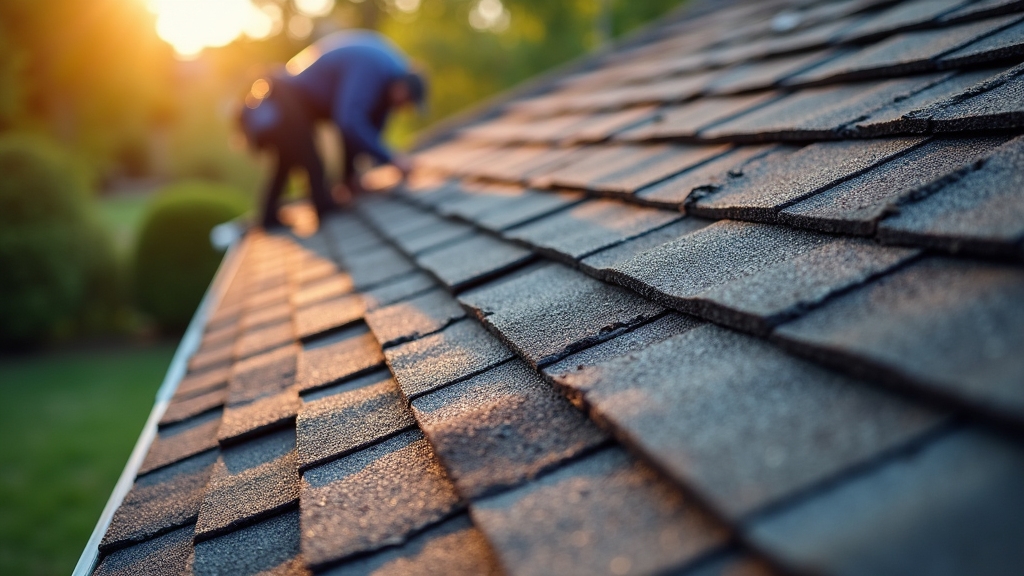Roof lifespan depends on material, installation quality, climate, and maintenance. Three-tab asphalt lasts about 15–20 years; architectural asphalt 25–35. Fiber-cement/composites run 30–50. Metal varies: galvanized steel 40–60, galvalume/aluminum 50–70, copper and zinc 70–100+. Tile lasts 50–100, slate 75–150+, wood 20–40. Flat roofs: TPO/PVC 20–30, EPDM 25–35, modified bitumen and built-up 20–30. Proper ventilation, flashing, fasteners, and semiannual inspections extend service life and reduce leaks. The following sections explain how to optimize outcomes.
Key Takeaways
- Roof lifespan depends on material, installation quality, climate exposure, ventilation, and maintenance.
- Typical lifespans: asphalt 15–35 years; metal 40–70+; tile/slate 50–150+; wood 20–40; single-ply/modified/BUR 20–35.
- Harsh sun, heat, wind, freeze-thaw, and coastal salt shorten roof life without robust detailing and materials.
- Proper installation, balanced attic ventilation, and manufacturer-compliant components significantly extend service life and preserve warranties.
- Semiannual inspections and timely repairs prevent leaks and can add years to a roof’s effective lifespan.
What Determines Roof Lifespan?
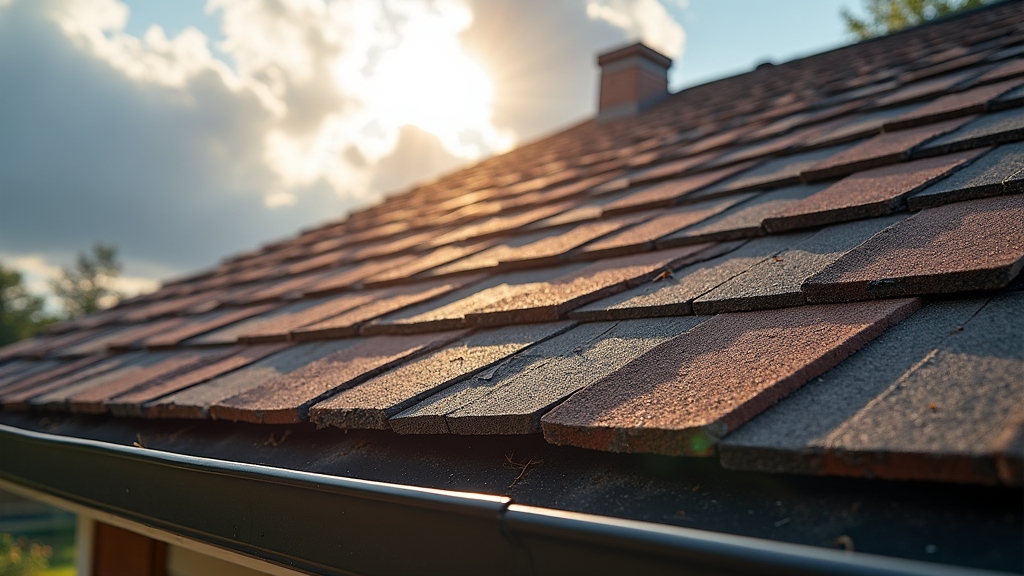
Roof longevity is primarily governed by material type, installation quality, climate exposure, and maintenance practices. Service life reflects the interaction of mechanical durability, UV resistance, thermal movement tolerance, and moisture shedding efficiency. Proper substrate preparation, ventilation, and flashings reduce stress concentrations, condensation, and leak pathways. Fastener selection, underlayment compatibility, and adherence to manufacturer specifications mitigate premature failures.
Durability hinges on materials, craftsmanship, climate stresses, and maintenance-driven moisture and movement control.
Climate imposes cyclic loads: UV radiation embrittles surfaces; freeze–thaw accelerates microcracking; wind uplift and wind-driven rain test anchorage and laps; hail induces impact damage; heat increases thermal expansion and asphalt volatilization; coastal salt promotes corrosion of metals and fasteners.
Roof geometry matters: low slope slows drainage; complex intersections multiply detailing risks. Attic ventilation and insulation control deck temperature, ice dam formation, and moisture accumulation.
Maintenance sustains performance by removing debris, correcting sealant failures, clearing gutters, and addressing localized damage early. Quality control, documented inspections, and timely repairs extend functional serviceability.
Average Lifespans by Roofing Material
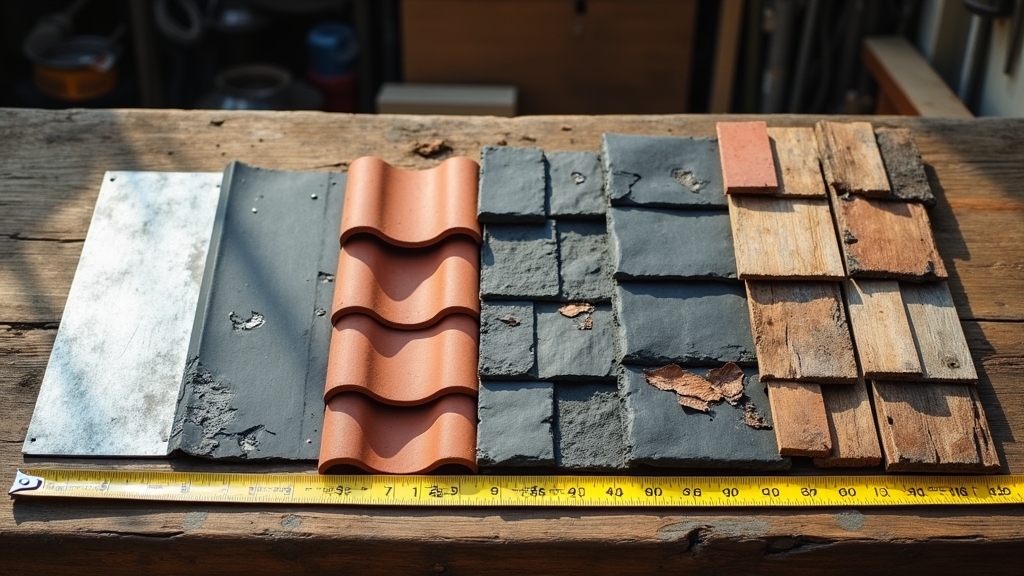
Across residential and commercial sectors, typical service lives cluster by material class: three-tab asphalt shingles often 15–20 years; architectural asphalt 25–35; fiber-cement/composite 30–50; standing seam steel 40–60 (galvanized) and 50–70 (galvalume/aluminum); copper and zinc 70–100+; clay and concrete tile 50–100 (underlayment often limits system life); natural slate 75–150+; wood shingles/shakes 20–40; single-ply membranes (TPO/PVC) 20–30; EPDM 25–35; modified bitumen 20–30; and built-up roofing 20–30.
These ranges reflect material durability, fastening systems, oxidation and UV resistance, thickness (mil/ga), and accessory quality (flashings, fasteners, coatings).
Warranty terms loosely align but are not synonymous with service life; they often assume compliant installation and maintenance. Heavier, denser, and more inert materials (slate, copper, tile) exhibit lower degradation rates, while organic binders and exposed seams generally shorten expectancy.
Factory finishes (PVDF on metal), high-quality underlayments, and robust surfacing on bituminous systems correlate with upper-range outcomes. Proper ventilation and drainage extend performance by minimizing thermal cycling and moisture-related deterioration.
Climate and Environmental Impacts
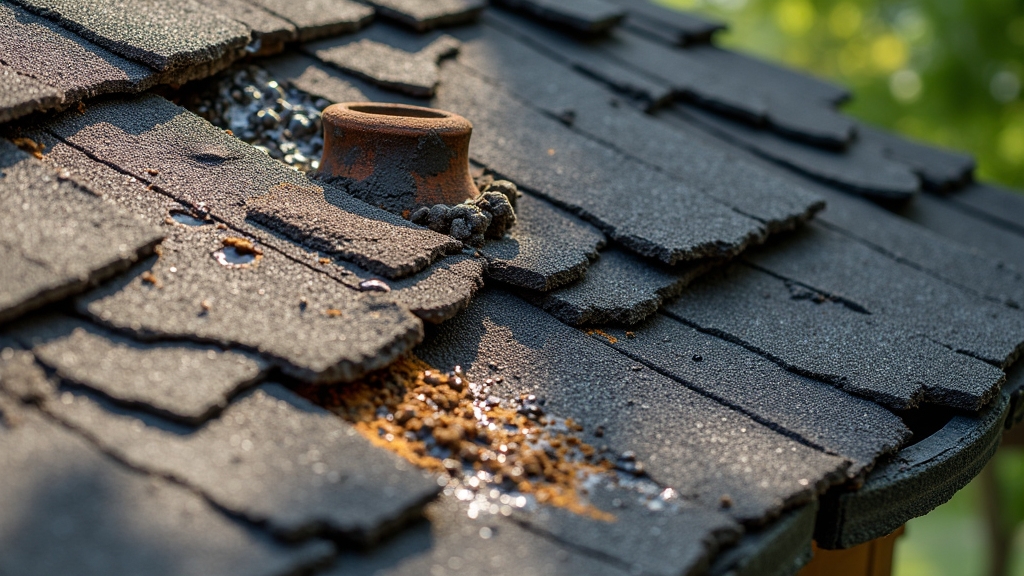
Climate and environmental conditions are primary drivers of roof aging and failure. High UV and heat accelerate material oxidation and thermal cycling, while rain, snow, and ice promote moisture intrusion, freeze–thaw damage, and ice dams.
Wind uplift, abrasive debris, and coastal salt increase mechanical wear and corrosion, shortening service life without targeted design and maintenance.
UV Exposure and Heat
Relentless ultraviolet radiation and heat accelerate roof aging by breaking down polymers, oxidizing oils, and driving thermal expansion-contraction cycles.
UV photons cleave molecular bonds in asphalt binders and single-ply membranes, increasing brittleness, microcracking, and granule loss. Elevated temperatures volatilize light fractions and promote oxidation, raising modulus and lowering elongation at break.
Dark, low-reflectance surfaces can exceed 70–80°C under peak sun, amplifying creep, sealant shrinkage, and fastener back-out. High diurnal swings intensify fatigue at laps, flashings, and penetrations.
Material response varies: SBS-modified bitumen outperforms oxidized asphalt; TPO can chalk and embrittle without adequate UV stabilizers; PVC resists UV but relies on plasticizers that migrate under heat.
Reflective coatings, stabilized polymers, increased granule coverage, UV-resistant surfacing, and robust ventilation reduce thermal load and degradation kinetics.
Rain, Snow, and Ice
While solar loading drives chemical aging, moisture imposes mechanical and hygrothermal stresses that are equally consequential for service life.
Rain elevates moisture content in porous materials, enabling freeze–thaw cycles that induce microcracking, granule loss, and seam fatigue. Water intrusion at fasteners and penetrations increases corrosion and undermines pullout capacity. Prolonged wetting degrades underlayments, reduces insulation R-value via saturation, and accelerates biological growth that traps moisture.
Snow loads impose sustained deflection, opening laps and stressing trusses; meltwater refreezes at eaves, forming ice dams that drive capillary backflow beneath shingles.
Repeated thaw–refreeze cycles propagate adhesive failures in asphaltic and modified-bitumen membranes. Ice accretion adds weight and concentrates stresses at gutters and terminations.
Effective control hinges on drainage continuity, vapor management, thermal bridging mitigation, and meticulous detailing at junctions and penetrations.
Wind, Debris, and Salt
In many regions, wind, airborne debris, and salt spray govern roof deterioration as much as temperature and moisture. Uplift pressures from gusts exploit edge metal, fastener rows, and seams; once breached, progressive peel-off accelerates.
Wind-driven debris abrades coatings, chips granules, and initiates punctures in membranes. Salt aerosol, prevalent within ~5–10 miles of coasts, accelerates corrosion of fasteners, flashing, and exposed steel; it also degrades aluminum via pitting and undermines protective paint systems.
Service life declines when design pressures (ASCE 7) exceed installed capacity, when edge securement (ANSI/SPRI ES-1) is inadequate, or when corrosion protection lags exposure class.
Mitigations include higher wind-rated assemblies, enhanced perimeter/field fastening, sealed laps, impact-resistant surfaces, corrosion-resistant alloys/coatings (e.g., 300-series stainless, G-235/Galvalume), sacrificial anodes where applicable, and disciplined inspection/maintenance.
Installation Quality and Ventilation
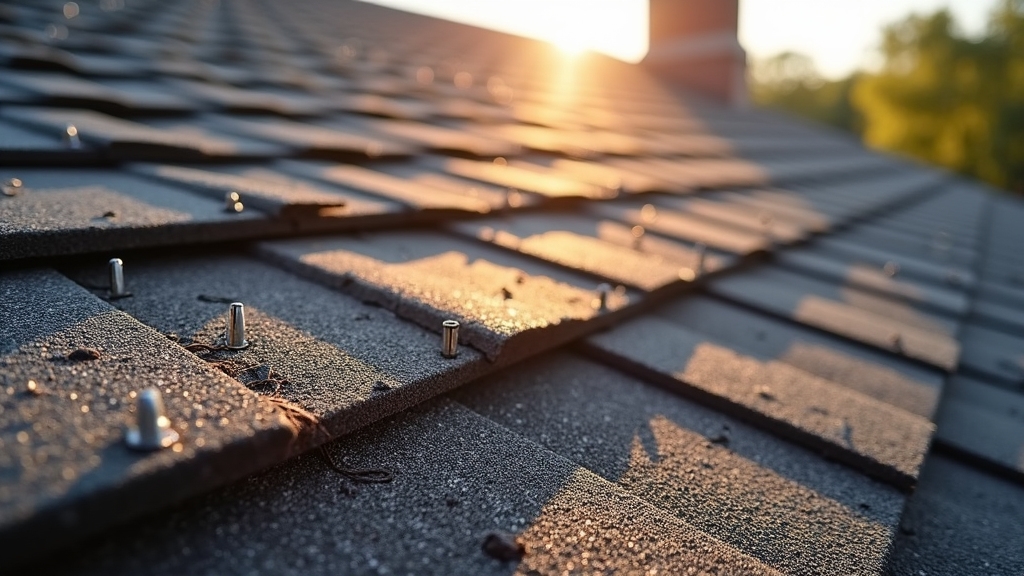
Although material selection sets the baseline for service life, roof longevity often hinges on installation quality and ventilation design. Improper fastening patterns, under-driven or over-driven nails, and misaligned courses concentrate stresses and invite wind uplift, shingle slippage, and early leaks.
Inadequate underlayment laps or poorly detailed valleys, penetrations, and step flashing become primary failure points. Manufacturer specifications for exposure, stagger, and fastener placement correlate with tested uplift ratings and warranty validity; deviation reduces performance margins.
Ventilation governs thermal and moisture loads in the roof assembly. Balanced intake and exhaust—typically achieving 1:150 net free vent area (or 1:300 with effective vapor barriers)—reduces deck temperatures, limits ice dam formation, and prevents interstitial condensation.
Elevated attic humidity accelerates corrosion of fasteners, promotes mold, and degrades asphalt binder or wood sheathing. Continuous soffit intake paired with ridge or high gable exhaust provides uniform airflow; point vents alone often short-circuit.
Air sealing ceiling planes complements ventilation by limiting moisture-laden air entry.
Maintenance Habits That Add Years
Regular inspections identify minor defects—loose shingles, flashing gaps, sealant failure—before they escalate.
Keeping gutters clear prevents ice dams, ponding, and capillary backflow that accelerate shingle decay and underlayment rot.
Prompt leak repairs limit moisture intrusion, preserving deck integrity and preventing mold, which collectively extends service life.
Routine Inspections Matter
While catastrophic leaks draw attention, modest, scheduled roof inspections prevent them and measurably extend service life. Evidence shows semiannual assessments, plus post-storm checks, catch small failures—loose flashings, sealant fatigue, lifted shingles—before water pathways form. Inspectors document defects, prioritize risk, and verify manufacturer-required maintenance, preserving warranty standing and slowing material aging via timely corrections.
| Inspection Focus | Failure Mechanism Detected | Corrective Action |
| Flashings/penetrations | Capillary intrusion, fastener back-out | Re-secure, reseal, replace fasteners |
| Field membrane/shingles | Granule loss, blistering, uplift | Patch, replace units, improve attachment |
| Valleys and junctions | Debris dams, scouring, deformation | Clear obstructions, restore slope, re-lap |
| Attic/underlayment | Condensation, thermal bypass | Improve ventilation, add vapor control |
Inspection intervals should align with climate stressors and roof type: asphalt (6 months), single-ply (6 months), metal (annual), tile (annual). Photographic logs and moisture readings quantify trends, guiding predictive maintenance and budget planning.
Keep Gutters Clear
Building on the value of scheduled inspections, gutter maintenance targets one of the most common water-management weak points. Clogged gutters and downspouts force water to back up under shingles, wet fascia and sheathing, and overload drip edges.
Recurrent saturation accelerates decay, degrades underlayment, and promotes ice dam formation in cold climates. Empirical field data and manufacturer guidance converge: free-flowing gutters reduce edge rot, paint failure, and fastener corrosion, extending service life.
Best practice includes semiannual cleanouts (spring, late fall), added frequency under overhanging trees, and verification of downspout discharge 5–10 feet from foundations.
Specify correctly sized gutters, adequate slope (about 1/16–1/8 inch per foot), securely fastened hangers, and screened or micro-mesh guards suited to local debris. Document conditions, photograph outlets, and correct ponding immediately.
Prompt Leak Repairs
Act quickly when leaks appear, because water intrusion accelerates deck rot, saturates insulation, corrodes fasteners, and compromises underlayment adhesion—shortening roof life.
Prompt repairs limit capillary movement along sheathing, prevent mold amplification in damp cavities, and avert freeze–thaw splitting in colder climates. Evidence from building forensics shows that small penetrations at flashings, pipe boots, or mechanical fasteners are common leak origins.
Best practice involves tracing moisture to the entry point, not merely the ceiling stain, then restoring waterproofing continuity: reseal or replace flashing, renew damaged shingles or membranes, and resecure loose fasteners with compatible sealants.
Replace wet insulation and any delaminated sheathing to halt concealed deterioration. Document repairs, verify with moisture meter readings and infrared scanning after rainfall, and schedule follow-up inspections to guarantee stability.
Early Warning Signs of Roof Wear
Telltale indicators of roof wear often appear subtly before leaks occur, and early detection reduces repair scope and cost. Observable shingle degradation includes granular loss exposing asphalt, edge cupping, surface cracking, and displaced tabs after wind events.
On metal systems, look for coating chalking, finish crazing, red rust at fasteners, and loose or backed-out screws.
Tile roofs exhibit cracked pans, slipped pieces, and eroded underlayment at penetrations. Flat membranes show alligatoring, seam lifting, blistering, and ponding that persists beyond 48 hours.
Ancillary signals include sagging planes, moss or lichen at north slopes indicating retained moisture, and dark streaking from biological growth or airborne particulates.
At the attic, daylight at penetrations, damp insulation, compressed batting, rusted nail tips (“nail frost”), and elevated sheathing moisture content (>16%) indicate compromised assemblies.
Flashings merit scrutiny: step and counterflash separations, deteriorated sealant at terminations, and corrosion at chimney saddles often precede visible interior staining.
When Repair Makes Sense vs. Replacement
When does a roof warrant targeted repairs versus full replacement? The decision hinges on damage scope, system age, and residual service life.
Localized defects—isolated blown-off shingles, minor flashing failures, punctures, or a few cracked tiles—typically justify repair when the deck is dry, underlayment intact, and moisture intrusion is contained.
Repair is justified for isolated defects when deck is dry and moisture intrusion is contained.
Infrared thermography, moisture meters, and core cuts (for low-slope) validate whether wet substrate exists; widespread wet insulation or rot signals replacement.
Replacement is indicated when deterioration is systemic: pervasive granule loss with exposed mat, curling or thermal splitting across slopes, brittle membranes, chronic leaks at multiple planes, or failed underlayment.
Near end-of-life roofs—e.g., asphalt at 80–90% of rated service, cedar with widespread decay, or single-ply with plasticizer loss and seam fatigue—favor replacement to restore assembly integrity.
Structural concerns (sagging deck), incompatible overlays, or code-triggered upgrades also tip the balance.
Prioritize root-cause correction to prevent recurrence.
Cost vs. Longevity: Finding the Right Balance
How can owners quantify the trade-off between upfront price and service life to minimize total roof ownership cost? The most defensible approach is life-cycle cost analysis (LCCA): compare systems using net present cost of materials, labor, disposal, financing, energy effects, and expected service life.
Cost per service year (or per watertight year) becomes the key metric, normalized by climate and exposure. Warranty length is not a proxy for durability; field data and ASTM/UL listings carry more weight.
- Compare cost per year: NPC ÷ verified service life. A higher bid can be cheaper over time if longevity is robust and maintenance modest.
- Model risk: include failure probability, leak consequence costs, and variability in aging; use sensitivity ranges for UV index, wind exposure, and foot traffic.
- Consider maintenance intensity: systems requiring frequent coatings or seam work may erode apparent savings; include scheduled maintenance and inspection costs in the LCCA to avoid optimistic bias.
Tips to Maximize Your Roof’s Life
Although materials and climate set the baseline, disciplined maintenance practices largely determine service life. Optimizing roof longevity begins with biannual inspections—post-winter and late fall—targeting flashing, penetrations, ridge lines, and drainage paths. Early correction of minor defects (lifted shingles, cracked tiles, open laps) prevents moisture intrusion and substrate decay.
Control water first. Keep gutters, scuppers, valleys, and downspouts clear; verify slope and eliminate ponding on low-slope assemblies. Maintain adequate attic ventilation (balanced intake/exhaust, ~1:300 NFVA guideline) to limit heat and moisture loads that accelerate shingle oxidation and fastener corrosion. Ascertain insulation continuity to minimize ice dams.
Protect details. Re-seal penetrations with compatible sealants; replace corroded fasteners with stainless or coated alternatives; maintain UV-stable coatings on single-ply and modified bitumen systems per manufacturer intervals.
Manage vegetation and overhanging limbs; exclude pests. After severe weather, conduct targeted assessments and document conditions.
Use only manufacturer-approved components; follow installation and warranty protocols. Establish a maintenance log to schedule actions and support claims.
Frequently Asked Questions
How Does Roof Color Affect Heat Absorption and Lifespan?
Roof color drives solar absorption: darker roofs absorb more heat, elevating deck temperatures, accelerating oxidation, embrittlement, and thermal cycling fatigue; lighter, high-SRI coatings reduce heat gain, HVAC loads, and UV degradation, typically extending shingle and membrane service life, especially in hot climates.
Do Homeowner’s Insurance Policies Cover Age-Related Roof Failures?
Generally, no. Most homeowner’s policies exclude wear-and-tear and age-related deterioration, covering only sudden, accidental losses. Coverage may apply if a covered peril (hail, wind) causes damage. Policy endorsements, deductibles, depreciation schedules, and maintenance documentation critically influence outcomes.
Can Solar Panels Shorten or Extend a Roof’s Lifespan?
Yes; solar panels can both extend and shorten lifespan. They shield roofing from UV and hail, reducing thermal cycling, but improper installation, penetrations, and trapped moisture accelerate degradation. Ideal outcomes require integrated mounting, flashed penetrations, airflow gaps, and substrate condition verification.
How Does Attic Insulation Interact With Roof Longevity?
Attic insulation influences roof longevity by moderating deck temperatures, reducing thermal cycling, and preventing ice dams via controlled heat loss. Proper insulation paired with balanced ventilation minimizes moisture accumulation, curbs mold and rot risk, preserves shingle adhesion, and stabilizes fastener performance.
What Warranties Typically Exclude Common Roof Aging Issues?
Manufacturers typically exclude normal wear, UV degradation, thermal cycling, granule loss, algae or moss staining, ponding water, improper ventilation, installation defects, inadequate maintenance, foot traffic, storm or impact damage, substrate movement, and unauthorized repairs or aftermarket coatings from roof warranties.
Final Thoughts
Roof longevity isn’t guesswork—it’s the outcome of material selection, installation quality, local climate, and consistent maintenance. Pair durable products with code-compliant flashing, balanced attic ventilation, and semiannual inspections, and you’ll push toward the upper end of every lifespan range listed above. When wear becomes widespread—or leaks keep returning—full replacement restores system integrity and delivers the best life-cycle value.
Ready to find out where your roof stands today? Start with a professional assessment and a clear plan.
Work with a local expert:
Premiere Roofing Macomb provides thorough roof inspections, warranty-ready roof replacements, and durable residential roofing in every major material—asphalt shingles, metal roofing, and composite roofing. Explore all services or learn about us.
Call us today (586) 496-4621 • Contact us to schedule your inspection or estimate.
Premiere Roofing Macomb—protecting homes, maximizing roof life, and delivering Michigan-ready performance.

